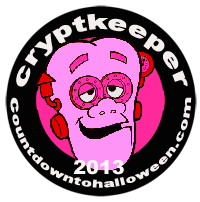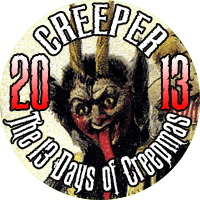*This article originally appeared in issue 37 of HorrorHound Magazine
In the 2000’s, Wes Craven is considered one of the elder
statesmen of horror. In the 80’s and
90’s, he was known as a hit-maker and master of his craft. In the 70’s, however, Craven was a young maverick
with a cinematic mean streak who refused to pull his punches. It was this Craven that gave us two of the
genre’s most ferocious and visceral classics, Last House on the Left and
The Hills Have Eyes. Both are
tales of warring families. In Last
House, the violence stems from a desire for sick kicks on one side and
vengeance on the other. In Hills,
the opposing clans are locked in a tribal battle simply for survival. Last House may be horror at its most
depraved, but The Hills Have Eyes is horror at its most primal.
It’s the story of The Carter family, three generations of
which are traveling cross-country. While
traversing the Nevada desert, they ignore a local’s advice to “stay on the main
road” (don’t they always?) and find themselves stranded in the middle of a
hostile, barren landscape. Even more
dangerous than the terrain is the primitive, feral group of cannibals (led by
Papa Jupiter) that is hunting them down.
Out of their element and backed into a corner, they are forced into a
savage kill-or-be-killed battle; leaving this peaceful family no choice but to
delve into their darkest primordial instincts to protect themselves, and their
loved ones, from their animalistic attackers.
Originally titled “Blood Relations: The Sun Wars” and
inspired by the legend of Sawney Bean and his Scottish family of flesh eaters, Hills
was slapped with an X rating by the MPAA when it was released in 1977. Extensive cuts were made, and that footage is
now believed to be lost, but the brutal power of the film still remains. One needs look no further than the infamous
“camper scene” to see the intensity Craven imbues his film with. In one single scene a man is burned alive, a
grandmother and a young mother are shot, another woman is raped, and a baby is
abducted to be eaten later. It’s as if
Wes wanted to see just how many taboos he could break in one scene. Today’s jaded horror audiences may have seen
it all, but watch this film in a packed theater and see if it doesn’t still
pack a wallop for the modern audience.
In ’77, however, The Texas Chainsaw Massacre was really the only
film that had even come close to this kind of merciless violence. Interestingly, in addition to thematic
similarities, these two films share an art director (Bob Burns) and some of the
same set dressings.
While 70’s horror was predominantly concerned with the
demonic and supernatural, Hills offered up realistic human-on-human
cruelty. No stylized violence here. The down and dirty murder and mayhem on
display in Hills wasn’t meant to be observed, it was designed to be
felt. No one was safe. The first death in the film is a German
Shepherd. The disemboweling of the family
dog was Craven’s way of throwing down the gauntlet and letting the viewer know
that he wasn’t playing by the rules. The
audience couldn’t help but wonder, “If he would kill a dog, would he kill a
baby?” In fact, infanticide was actually
considered at one point, with the cast and crew threatening “if he kills the
baby, we’re outta here.”
In addition to proving that this Craven kid was no one hit
wonder, Hills kick started the careers of two other horror icons. Dee Wallace, who previously had a bit part in
The Stepford Wives, got her big break in Hills before going on to
star in such landmark fright flicks as The Howling and Cujo. After making his screen debut in One Flew
Over The Cuckoo’s Nest, Michael Berryman made his first foray into the
macabre with Hills. He has since
become a mainstay in the horror genre and frequent convention guest, but Pluto
is still arguably the role he is best known for. Coincidentally, his is probably the image
most closely associated with the film today.
The Hills Have Eyes was a modest success upon its
initial release. It did well enough to
spawn a sequel in 1985, which was directed and later disowned by Craven. Mind Ripper, released in 1995, was
marketed in some areas as The Hills Have Eyes 3 (or The Hills Still
Have Eyes) despite having absolutely nothing to do with the series. The original Hills has since become a
revered cult classic, gaining a new following during the home video boom of the
80’s. One interesting indication of the
film’s place in horror history is the presence of a torn The Hills Have Eyes
poster on the basement wall in The Evil Dead, although it’s unclear
whether this is an homage to the film in general or a call back to the torn Jaws
poster in the Carter’s camper. Then,
in 2006, Craven and original Hills producer Peter Locke (who also played
Mercury) teamed with director Alexandre Aja for a hit remake. The remake proved popular enough to spawn its
own sequel and a comic book spin-off.
The impact of The Hills Have Eyes is undeniable even
three and a half decades after its release.
While “rural survival horror” had been around previously, Hills
laid out a lot of the template for the “you folks don’t belong ‘round these
parts” style flicks that would follow.
The legacy of Craven’s classic slice of wilderness brutality can be felt
in films from Just Before Dawn all the way up through Wrong Turn
and, in a role reversal, The Woman.
As long as city slickers foolishly stray into unfamiliar territory - and
as long as marauding inbred cannibals are there to terrorize them - the specter
of The Hills Have Eyes will be there, warning us to stay on the main
road. For the sake of the horror genre,
I hope mankind never learns that lesson.










No comments:
Post a Comment